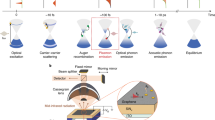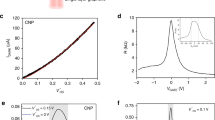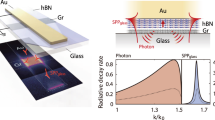Abstract
Photoemission plays a central role in a wide range of fields, from electronic structure measurements to free-electron laser sources. In metallic emitters, single-photon1, multiphoton2,3,4,5 or strong-field emission6,7,8,9,10 processes are the primary photoemission mechanisms. Here, using a sub-work-function 3.06 eV continuous-wave laser, photoemission from waveguide-integrated monolayer graphene is observed to occur at peak power densities >5 orders of magnitude lower than reported multiphoton and strong-field emission6,11,12. The behaviour is explained by the emission of hot electrons in graphene. In monolayer graphene, the need for photoelectrons to be transported to an emitting surface is eliminated, dramatically enhancing the probability of emission before thermalization. These results indicate that integrated-photonics-driven hot-electron emission provides a rich new area of exploration for both electron emission and integrated photonics.
This is a preview of subscription content, access via your institution
Access options
Access Nature and 54 other Nature Portfolio journals
Get Nature+, our best-value online-access subscription
$29.99 / 30 days
cancel any time
Subscribe to this journal
Receive 12 print issues and online access
$209.00 per year
only $17.42 per issue
Buy this article
- Purchase on Springer Link
- Instant access to full article PDF
Prices may be subject to local taxes which are calculated during checkout





Similar content being viewed by others
Data availability
The data that support the plots within this paper and other findings of this study are available from the corresponding author upon reasonable request.
Code availability
The ensemble Monte Carlo Boltzmann Transport Equation Solver source codes are available from the corresponding author upon reasonable request.
References
Spicer, W. E. Photoemissive, photoconductive, and optical absorption studies of alkali-antimony compounds. Phys. Rev. 112, 114–122 (1958).
Ropers, C., Solli, D., Schulz, C., Lienau, C. & Elsaesser, T. Localized multiphoton emission of femtosecond electron pulses from metal nanotips. Phys. Rev. Lett. 98, 043907 (2007).
Weber, T. et al. Correlated electron emission in multiphoton double ionization. Nature 405, 658–661 (2000).
Bechtel, J., Smith, W. L. & Bloembergen, N. Two-photon photoemission from metals induced by picosecond laser pulses. Phys. Rev. B 15, 4557–4563 (1977).
Logothetis, E. & Hartman, P. Laser-induced electron emission from solids: many-photon photoelectric effects and thermionic emission. Phys. Rev. 187, 460–474 (1969).
Bormann, R., Gulde, M., Weismann, A., Yalunin, S. & Ropers, C. Tip-enhanced strong-field photoemission. Phys. Rev. Lett. 105, 147601 (2010).
Piglosiewicz, B. et al. Carrier-envelope phase effects on the strong-field photoemission of electrons from metallic nanostructures. Nat. Photon. 8, 37–42 (2014).
Dombi, P. et al. Ultrafast strong-field photoemission from plasmonic nanoparticles. Nano Lett. 13, 674–678 (2013).
Schenk, M., Krüger, M. & Hommelhoff, P. Strong-field above-threshold photoemission from sharp metal tips. Phys. Rev. Lett. 105, 257601 (2010).
Putnam, W. P., Hobbs, R. G., Keathley, P. D., Berggren, K. K. & Kärtner, F. X. Optical-field-controlled photoemission from plasmonic nanoparticles. Nat. Phys. 13, 335–339 (2017).
Barwick, B. et al. Laser-induced ultrafast electron emission from a field emission tip. New J. Phys. 9, 142 (2007).
Yang, D.-S., Mohammed, O. F. & Zewail, A. H. Scanning ultrafast electron microscopy. Proc. Natl Acad. Sci. USA 107, 14993–14998 (2010).
Ma, Q. et al. Tuning ultrafast electron thermalization pathways in a van der Waals heterostructure. Nat. Phys. 12, 455–459 (2016).
Breusing, M. et al. Ultrafast nonequilibrium carrier dynamics in a single graphene layer. Phys. Rev. B 83, 153410 (2011).
Betz, A. et al. Supercollision cooling in undoped graphene. Nat. Phys. 9, 109–112 (2013).
Graham, M. W., Shi, S.-F., Ralph, D. C., Park, J. & McEuen, P. L. Photocurrent measurements of supercollision cooling in graphene. Nat. Phys. 9, 103–108 (2013).
Falkovsky, L. A. Optical properties of graphene. J. Phys. Conf. Ser. 129, 012004 (2008).
Falkovsky, L. & Pershoguba, S. Optical far-infrared properties of a graphene monolayer and multilayer. Phys. Rev. B 76, 153410 (2007).
Ferrari, A. C. et al. Raman spectrum of graphene and graphene layers. Phys. Rev. Lett. 97, 187401 (2006).
Lumerical https://www.lumerical.com/tcad-products/fdtd/ (2012).
de Vega, S. & de Abajo, F. J. G. Plasmon generation through electron tunneling in twisted double-layer graphene and metal-insulator-graphene systems. Phys. Rev. B 99, 115438 (2019).
Acknowledgements
This work was supported by AFOSR grant no. FA9550-16-1-0306 and the Molecular Foundry at Lawrence Berkeley National Laboratory, a user facility supported by the Office of Science, Office of Basic Energy Sciences of the US Department of Energy (DOE) under contract no. DEAC02-05CH11231. R.A acknowledges a USC Provost Graduate Fellowship.
Author information
Authors and Affiliations
Contributions
F.R. and R.K. designed the experiments. F.R. carried out the sample fabrication and measurements. Q.L. carried out graphene growth. R.A. and R.K carried out the electronic simulations. F.R. carried out the optical simulations. All authors contributed to analysing the data. F.R., R.A., H.U.C. and R.K. wrote the paper while all authors provided feedback.
Corresponding author
Ethics declarations
Competing interests
The authors declare no competing interests.
Additional information
Publisher’s note Springer Nature remains neutral with regard to jurisdictional claims in published maps and institutional affiliations.
Supplementary information
Supplementary Information
Supplementary details, Figs. 1–11 and refs. 1–17.
Rights and permissions
About this article
Cite this article
Rezaeifar, F., Ahsan, R., Lin, Q. et al. Hot-electron emission processes in waveguide-integrated graphene. Nat. Photonics 13, 843–848 (2019). https://doi.org/10.1038/s41566-019-0524-1
Received:
Accepted:
Published:
Issue Date:
DOI: https://doi.org/10.1038/s41566-019-0524-1



